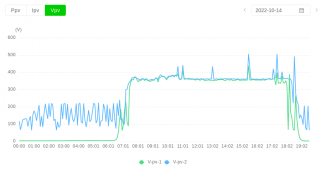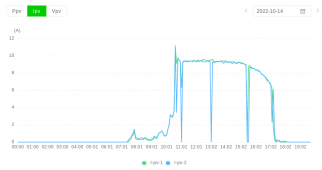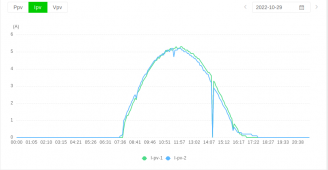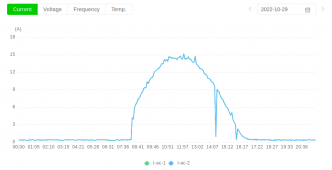There's something going on with either the Sol-Ark or the arrays. Arrays are 9 panels 400 watt Solaria. 2 arrays. One array per dual axis tracker.
The main symptoms I see are PV voltage spiking while at the same time the PV current going to 0 or near 0. It seems to occur to both arrays at the same time however today was an exception. Today PV2 array(blue line) was looking worse than PV1 array(green line). In prior says I turned off 1 array while leaving the other on and vice-versa. Same results from either array when the other array is off.The disconnect switches cut off both positive and negative and are fused.
Here are some charts from PowerView


The other mystery is that PV2(blue) has a high Vpv when there is no sun. I try to measure this voltage with my DMM (AC or DC) and just get a couple volts that varies alot. So I can not confirm this voltage.
I did call Sol-Ark today but that was a couple hours before closing. I left a voice message.
Any ideas of where to start troubleshooting?
This is an older system that now has new panels and inverters. There are 2 more identical trackers/arrays that go to a SunnyBoy grid tie inverter. This half of the system has no problems.
The main symptoms I see are PV voltage spiking while at the same time the PV current going to 0 or near 0. It seems to occur to both arrays at the same time however today was an exception. Today PV2 array(blue line) was looking worse than PV1 array(green line). In prior says I turned off 1 array while leaving the other on and vice-versa. Same results from either array when the other array is off.The disconnect switches cut off both positive and negative and are fused.
Here are some charts from PowerView


The other mystery is that PV2(blue) has a high Vpv when there is no sun. I try to measure this voltage with my DMM (AC or DC) and just get a couple volts that varies alot. So I can not confirm this voltage.
I did call Sol-Ark today but that was a couple hours before closing. I left a voice message.
Any ideas of where to start troubleshooting?
This is an older system that now has new panels and inverters. There are 2 more identical trackers/arrays that go to a SunnyBoy grid tie inverter. This half of the system has no problems.
Last edited:






